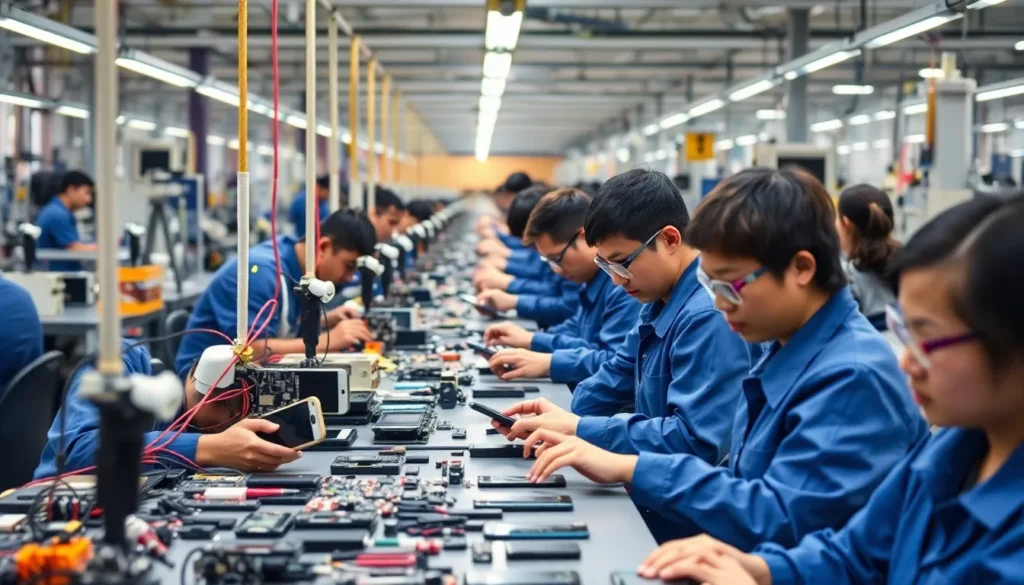Table of Contents
ToggleEver wondered where that sleek smartphone in your pocket was born? Spoiler alert: it didn’t just pop out of thin air! The journey of a phone is as intricate as a soap opera plot, spanning continents and cultures. From the factories buzzing in China to the high-tech labs in South Korea, each device carries a story that’s as fascinating as its features.
Global Manufacturing Locations
Smartphones are crafted in several key regions worldwide. China stands out as the leading hub for manufacturing, housing major factories for brands like Apple, Huawei, and Xiaomi. These factories often produce millions of devices each year due to China’s established supply chain.
Taiwan plays a crucial role in semiconductor manufacturing. Companies like TSMC develop advanced chips, integral for smartphone functionality. In addition, South Korea ranks highly for innovation in high-tech labs. Samsung and LG contribute to breakthroughs in display technology and battery development.
India emerges as an important player in recent years. Manufacturing plants from companies such as Samsung and Xiaomi in India benefit from lower labor costs and favorable government policies. This shift reduces dependence on Chinese factories.
Vietnam is also gaining prominence as a manufacturing site. Several electronics manufacturers, including LG and Samsung, have shifted a portion of production there to diversify their supply chains. Labor costs contribute to Vietnam’s appeal.
Japan supplies high-quality components, particularly camera technology and sensors. Brands like Sony lead the way in providing key parts for smartphones.
Each country plays a unique role in the manufacturing process. While production sites may differ, every smartphone’s journey incorporates these global manufacturing locations.
Major Phone Manufacturers

Several major manufacturers dominate the smartphone industry, each contributing to global production in unique ways.
Apple
Apple designs its devices in California, but significant production occurs in China. Foxconn and Pegatron, two key suppliers, assemble most iPhones. Growing interest in local production led Apple to expand operations in India. The company’s strategy includes diversifying its supply chain to reduce dependence on Chinese manufacturing. Innovations like the A-series chip happen in the U.S., while components from Japan and South Korea enhance quality and performance.
Samsung
Samsung combines design and manufacturing primarily in South Korea. Samsung’s flagship devices, such as the Galaxy series, undergo assembly in Vietnam and India to meet global demand. The company’s semiconductor production, a vital component of smartphones, also takes place in South Korea. With a focus on innovation, Samsung invests heavily in display technology, leading the market in OLED screens. Establishing factories across various countries showcases its commitment to efficient production.
Huawei
Huawei operates primarily from China, where it assembles most of its smartphones. The company emphasizes research and development, establishing high-tech labs to drive innovation. Recently, Huawei expanded manufacturing facilities in Vietnam and India, aiming to mitigate supply chain risks. Partnerships with local suppliers strengthen its production capabilities. Additionally, Huawei’s commitment to 5G technology positions it as a key player in the smartphone sector.
Factors Influencing Phone Manufacturing
Manufacturing smartphones involves various factors, significantly impacting where devices are produced.
Labor Costs
Labor costs play a crucial role in determining the location of phone manufacturing. Countries like China and India offer lower wages, making them attractive for assembly and production. Indian labor rates are about 24% lower than in China, leading manufacturers to invest in India to reduce operational expenses. As a result, brands like Apple and Samsung are increasing their presence in India. Competitiveness in labor pricing influences companies to consider less expensive regions, ensuring they maintain profit margins while meeting market demands. Economic conditions affect these costs, creating fluctuations that influence shifts in manufacturing strategies.
Supply Chain Logistics
Supply chain logistics significantly affect production efficiency in smartphone manufacturing. Proximity to suppliers often dictates the choice of manufacturing locations. China boasts a well-established infrastructure supporting rapid distribution of materials and components. In contrast, India is developing its logistics network, which enhances its manufacturing appeal. Efficient transportation reduces delays and costs, allowing manufacturers to respond to market changes swiftly. Moreover, diversifying supply chains helps mitigate risks associated with geopolitical instability. As companies explore countries like Vietnam and India, logistics considerations increasingly shape their strategic decisions in the global smartphone industry.
Trends in Mobile Phone Production
The landscape of mobile phone production is constantly evolving. Manufacturers increasingly diversify their supply chains to reduce dependency on single countries. In recent years, India has become a key player, attracting brands due to its lower labor costs and favorable government initiatives aimed at boosting local manufacturing. Data shows that Indian labor rates are about 24% lower than those in China, making it an attractive option for companies like Apple and Samsung.
New technologies also drive production trends. South Korea remains a leader in innovations pertaining to display technology and battery development, providing high-quality components crucial for modern smartphones. As companies seek advanced features, the push for better camera technology continues, with Japan contributing significantly in this area.
Vietnam is gaining traction as a production site, often viewed as a viable alternative to China. Its strategic location and developing infrastructure support manufacturers looking to establish a more balanced supply chain. Recent investments in Vietnamese factories reflect this shift, with major brands increasing their assembly operations in the country.
The complexity of global supply chains influences manufacturing decisions. Proximity to essential suppliers often guides production site selections. Established infrastructures in China facilitate rapid distribution, but the growing logistics capabilities in India and Vietnam enhance their appeal.
Sustainability initiatives also affect production trends. Many companies now focus on eco-friendly practices, looking to reduce their carbon footprints and engage in responsible sourcing. This shift is reshaping the landscape of mobile phone production, as brands adapt to consumer demands for sustainability alongside technological advancements.
The global smartphone manufacturing landscape is intricate and ever-evolving. As companies navigate the challenges of supply chain management and labor costs, they’re increasingly looking beyond traditional hubs like China. The rise of India and Vietnam as key players signals a shift towards more diversified production strategies.
Innovation continues to thrive in regions such as South Korea and Japan, where advancements in technology enhance the quality and capabilities of smartphones. As sustainability becomes a priority for consumers, manufacturers are adapting their practices to meet these demands. The future of smartphone production will likely be shaped by these trends, reflecting a more interconnected and dynamic global market.





